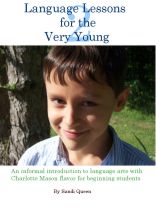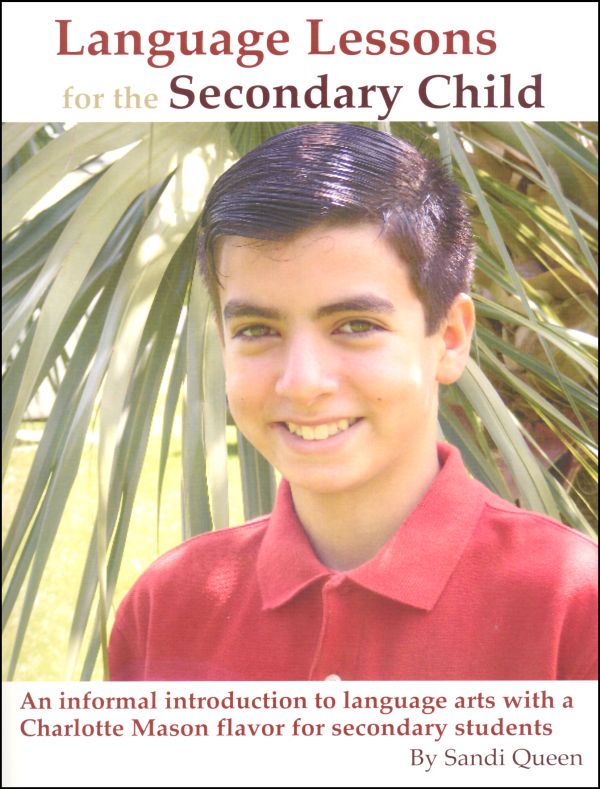Sandi Queen's Language Lessons worktexts offer a Charlotte Mason approach for learning language arts for preschool through high school. These softcover books include full color photos and reproductions of paintings to be used for observation and picture studies. Books also include copywork, narration activities, and poetry, along with instruction in grammar, usage, and composition skills. Although Charlotte Mason preferred that parts of speech not be taught before age eight or nine, Queen's books introduce nouns, verbs, subjects, and predicates in Language Lessons for the Very Young, Volume 1 which is recommended for grades 2 and 3. Some parents might appreciate this earlier introduction of parts of speech since that is common to most other programs for the early grades.
Lined space for copywork is included within each book along with space for brief answers to questions and composition work. This means that books are consumable and you will need one for each student. Copywork gradually expands from copying letters (at preschool level) to copying lengthy poems and literary passages. A nice touch is the division of lengthy copywork exercises into sections so that students can see and copy without having to continually flip pages.
Throughout all of the books, language related to church and Christian faith make this series particularly appropriate for a Christian audience. As was the case in Charlotte Mason's own teaching, lessons frequently center around pictures, poetry, and copywork with themes from nature, animals, and life lived largely in an agrarian world.
Each book has 180 lessons, but lessons vary in difficulty and time required. Some will be very brief and others, such as writing an essay at upper levels, will take much longer. Each course should take about one school year to complete. Courses are very flexible as to the grade level of the student. You might start with any of these books as long as students have acquired basic skills in some fashion. That makes is easy to have two or more children working in the same book if they are not too far apart in age and ability. There are no separate teacher manuals, but answer keys are available beginning with the Very Young courses.
Most children should find these courses very manageable and less overwhelming than traditional grammar and language arts workbooks. Instruction is not as thorough and rigorous as in resources such as Rod and Staff or A Beka language courses. Students should be able to do much of their work independently once they are in Language Lessons for the Very Young. However, parents need to listen to narrations and occasionally read poems to students. Once in a while a lesson has a note to parents regarding important points for parents to discuss with children. Even older students rely on parents for dictation.
Following is a brief description of the target audience and content of each course.
Little Ones, Volume 1 (ages 3 to 5) introduces upper and lower case letters, picture studies, narration, and poetry appreciation. While children are to copy both upper and lower case letters, there are no instructions on how to form letters.
Little Ones, Volume 2 (ages 4 to 6) continues with Charlotte Mason techniques while also introducing phonics. This is not a complete phonics program. In Volume 2 children copy words and brief sentences.
Little Ones, Volume 3 (age 5 until a student is reading fluently and is ready for Very Young, Volume 1) offers more work with phonics and Charlotte Mason methods to cement basic language arts skills.
Very Young, Volume 1 (about age 6 or 7- when a student has learned to read) - This course might be your starting point in this series since it utilizes Charlotte Mason methods (narration, picture study, and copywork) while also teaching capitalization, punctuation, singular/plural, nouns, verbs, subjects, and predicates.
Very Young, Volume 2 (grades 3 and 4) is almost identical in concept coverage to Volume 1.
Elementary Child, Volume 1 (ages 8 to 12) – While this volume continues to incorporate Charlotte Mason's methods, it has more grammar and usage lessons with some creative writing.
Elementary Child, Volume 2 (ages 12 to 15) is similar in content to Volume 1 but at more advanced levels.
Secondary Child, Volume 1 (ages 10 to 15) teaches parts of speech, grammar usage, and punctuation while lessons continue with copywork, picture studies, narrations, letter writing, and creative writing. This volume introduces dictation exercises with poetry.
Secondary Child, Volume 2 (ages 12 to 16) is similar to Volume 1, but this course uses famous historical speeches for dictation and copywork exercises.
High School Student, Volume 1 shifts the focus from grammar to composition while using dictation and editing exercises and a great deal of work on creative writing.
High School Student, Volume 2 concentrates on essay writing.
High School Student, Grammar Review and More reviews grammar completely and also works on creative writing, picture studies, and dictation.




















